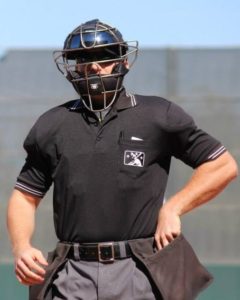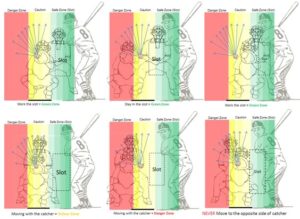All,
As the season nears, it is always prudent to address protective equipment in order to maximize on-field safety for everyone.
Chest Protector Fit
All umpires should take a moment to ensure proper chest protector fit prior to (and even periodically during) the season. Chest protector harnesses should be adjusted so as to allow the protector to sit snugly and high on the neck. While this may leave some of the lower ribs exposed while standing, a plate stance proper torso lean should allow these ribs to be protected from a direct shot by the lower portion of the protector while working the plate. More importantly, a protector snug on the neck will eliminate the potential for an umpire to take a direct shot to the neck.
When fitting a chest protector, umpires are encouraged to assume their plate stance to ensure proper overlap between the bottom of the mask’s throat guard and the top of the chest protector. In the photos below, you will see that even though there appears to be proper overlap when the umpire is standing, the chest protector slides down when the umpire assumes their stance, leaving their neck vulnerable. This umpire needs to tighten the harness of their chest protector to ensure a proper fit.
In the event an umpire cannot close this gap, we strongly recommend purchasing an additional throat guard and attaching it to the bottom of the mask. Throat guards are available in 4″ and 6″ length from a variety of manufacturers; when selecting one to attach, the key component is to ensure that the throat guard is long enough, in the event of impact, for the bottom of the guard to make contact with the chest protector, instead of being too short and simply pivoting up into the umpire’s neck.
Please note that no throat guard can prevent an umpire from the risk of being struck in the neck by a foul ball which deflects up toward the umpire off of the ground.
Mask Selection
Scientifically, there is no data to suggest that there is any difference in concussion prevention between hockey-style or traditional face masks. Preliminary data surrounding the Force-3 Defender mask indicates a reduction of force exerted onto the head of a user upon being struck by a baseball when compared to a traditional mask, but there is no data available yet to conclude the Force-3 is more likely to prevent a concussion then any other type of mask currently available.
Wilson has long been the most popular choice among professional umpires, by far, although we would recommend avoiding their titanium models, as they are very prone to denting. All-Star, Champro, Honig’s and the rarer Mizuno and Nike masks are also popular at the professional level. We would caution any members who work upper-level baseball from purchasing a Diamond or Rawlings mask.
Masks should be inspected for dents on a consistent basis, particularly after a significant head blow. Any masks that have been dented should be replaced immediately.
Mask Pads
The O Zone in the atmosphere has been shown to degrade the protective padding of mask pads over time. Therefore, umpires should consider replacing their mask pads, regardless of number of games worked, at least once every two seasons. Professional umpires are directed by their medical staffs to replace their mask pads prior to each season.
We highly recommend replacing any old padding with new mask pads from Team Wendy. Made of the same impact-resistant zorbium foam used in the helmets of the US military, these are regarded as the best mask pads on the market. Wilson mask pads are also highly regarded.
Other Tips
– Make sure you are truly working in the slot
While there is no location on the field, except the press box, where an umpire will truly be immune from being struck by a ball, proper use of the slot significantly reduces the likelihood of an umpire suffering a head-blow. Take a moment to review the following diagram about proper slot use (from the perspective of the pitcher with a right-handed batter – the positioning would invert for a left-handed batter).
Umpires should strive to position themselves exclusively in the green zone, avoiding the yellow zone as much as possible and the red zone at all costs! Recall that it is the batter and catcher that define the slot, not an arbitrary limitation such as the inside corner of the plate, or even the inside line of the batter’s boxes.
Be sure to have a good dialogue with your partner(s) after each game, or reviewing video footage should you be assigned to any Junior Intercounty game, to ensure you are truly in the slot. Base umpires, do not hesitate to make a partner alert that they are working too far over the plate if you notice over the course of the game. Proper slot work is a crucial element that HBUA evaluators will be looking for during observations throughout the season.
– Be prepared for and recognize the signs of a potential concussion
While minor baseball teams are not required to have a certified athletic trainer in the dugout, all HBUA umpires should be prepared to react accordingly in the event their partner could potentially suffer a concussion. First and foremost, this means bringing full plate equipment to every game, even if you are scheduled to work only the bases.
In the event your partner suffers a head blow, no matter how seemingly-insignificant, begin to leave your position to check on them. Even if your partner waves you off and says they are okay, make sure to conference at the next half-inning to ensure everything is okay.
As a plate umpire, if there are even the most faint feelings of “having your bell rung” or “needing to shake out the cobwebs”, consider taking a moment before resuming the game. If there is even a remote possibility that you may have suffered a concussion, leave the game immediately and seek medical attention. Subsequent head blows to an umpire who has already suffered a concussion can lead to a potentially traumatic brain injury.



